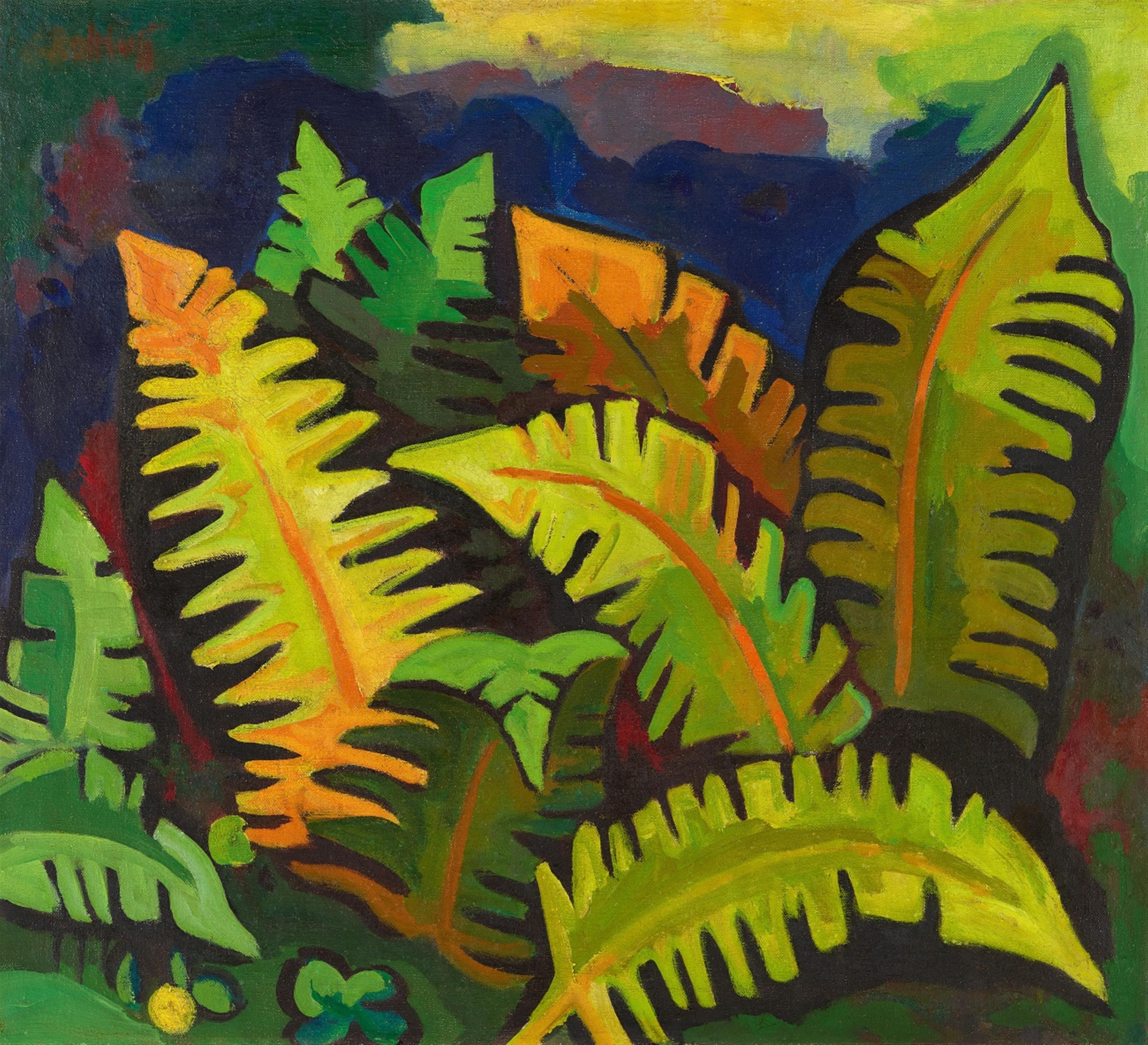Karl Schmidt-Rottluff
Farnkraut
1936
Oil on canvas 76 x 85 cm Framed. Signed upper left 'S-Rottluff'. Additionally signed and titled 'Schmidt=Rottluff "Farnkraut"' in black brush on the verso on upper stretcher bar and with work number '((364))'; annotated '=gewachst=' on lower stretcher bar. - In few places with minor craquelure, in the right outer fern tiny colour losses. In the upper left corner with slightly irregular old colour losses, restored, as well as mainly in the lower half of the picture with minimal islolated professional retouches.
Ferns - are they not well known as primal, vigorously growing as well as expansive botanical organisms possessing an unmistakably exotic silhouette with decorative leaves which unfold from the strangely fantastic forms of their buds, living organisms … Schmidt-Rottluff develops this characteristic and flexible growth into a strong internal form; the effect of the contour as a pattern is concise, it is employed expressively and fills the picture. The artist has deliberately shaped the natural, varied movement of the fern's angular and elongated fronds and intensified the motif not just in its dimensions, but also through strong contrasts of colour and brightness. Beyond the autumnal tones of its colouring, the painting develops an intense luminosity of a highly emotional character. A warm yellowish orange emerges out from among the bold hues to take on a life of its own, contrasting magnificently with the various shades of green, blue and violet. The effect seems harmonious, but it is also sealed off within the view selected for depiction, monumentalised, jolting, such that we are inclined to identify an unconscious or conscious metaphor - particularly when calling to mind other Schmidt-Rottluff paintings from this period which present a similarly dramatic luminosity in their colours. These were fateful years for the artist, whose work fell victim to denunciation, stigmatisation and confiscation.
Ernst-Wilhelm Nay can be cited in this context. He wrote to Schmidt-Rottluff in 1963, on the occasion of his 80th birthday: “In that difficult period of the Hitler regime, in which we were called 'degenerates', we became friends. The hieroglyphs, the symbolic forms that you - waiting within the magical - were able to bring nature to present to you as gifts were worth the admiration of the whole world. Without heeding the smears to which your art was exposed at that time, you wandered in the present, awaiting - waiting with the greatest sensibility - new gifts, from nature, the receiving of which was your true existence. It is a great artistry, to render visible that which itself wishes to become visible.” (cited in: exhib. cat. Karl Schmidt-Rottluff, Gemälde, Aquarelle, Graphik, Frankfurter Kunstverein 1964, p. 9).
Certificate
We would like to thank Christiane Remm for kind information and advice; the painting is registered in the archive of the Karl und Emy Schmidt-Rottluff Stiftung, Brücke Museum Berlin.
Provenance
Formerly Irmgard Hasenclever, Langerwehe; since then in family possession, private collection, North Rhine-Westphalia, estate
Literature
Will Grohmann, Karl Schmidt-Rottluff, Stuttgart 1956, Chronologischer Oeuvrekatalog der Gemälde, p. 302 ("Farnkraut. 85:75 cm; Frau Irma Hasenclever, Langerwehe über Düren; nicht bezeichnet")

